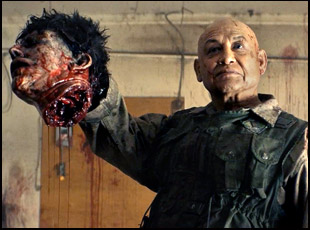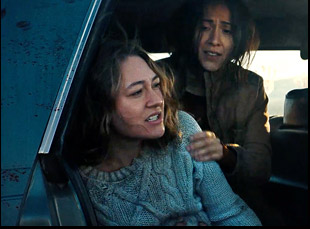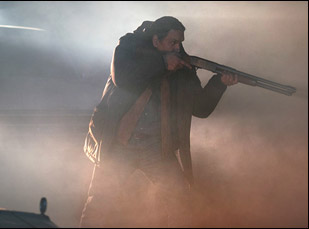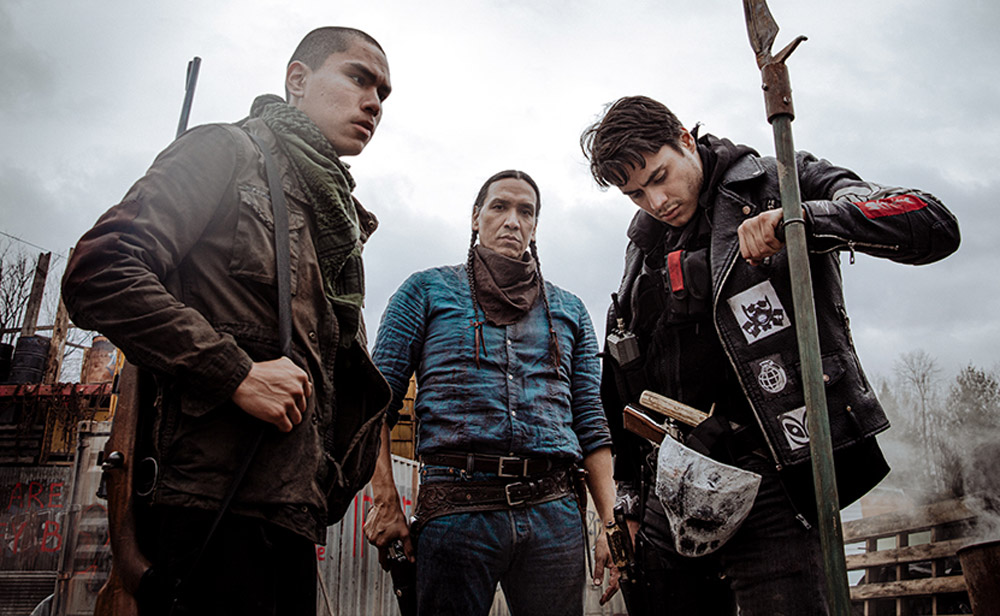There were supposed to be more characters that got to live by the end of “Blood Quantum,” but the movie gods just weren’t having it.
“There were supposed to be survivors from the church and survivors getting off the boat,” recalls writer/director Jeff Barnaby of shooting the climax for his second feature, which proved to be far more exciting than even he would’ve liked it to have been. “But we didn’t have the time to shoot that because the weather fucked up the whole morning and we ended up having to basically riff the rest of the day.”
Barnaby may have been prevented from bringing more extras to the set as he had hoped out of safety concerns, but for a film that takes no prisoners, this seemed about right. The filmmaker wasn’t only taking on freak snowstorms and 10-year floods on the coast of Quebec, but the full freight of history in making “Blood Quantum,” a wildly inventive horror film that presupposes that the indigenous community is immune to the outbreak of a zombie plague, making the Red Crow Indian Reservation a suddenly popular destination for outsiders looking to protect themselves.
All kinds of ugly things that were thought to be dead come back to life during the apocalyptic event, with “Blood Quantum” taking on a prescience during the current pandemic that Barnaby couldn’t have possibly imagined when observing how a crisis exacerbates already existing fissures within the world — even when the long-marginalized have inherent power, they are distrusted and made to feel inferior – and finds it generationally as well between the family that sets up the barricades around Restigouche, with the town’s sheriff Traylor (Michael Greyeyes) deputizing his old man Gisigu (Stonehorse Lone Goeman) to come back into the fold, while he has to keep an eye on rebellious sons Lysol (Kiowa Gordon) and Joseph (Forrest Goodluck), the latter of whom has a pregnant non-Native girlfriend (Olivia Scriven) to worry about. However, Barnaby manages to pull off a film that speaks to the times we’re in while coming across as the best kind of escapist fare, reinventing the kinds of genre thrills that he experienced watching Shock Theater on ASN as a kid, carrying a knowledge as deep of cinematic horror as of the real horrors of colonialism because of his Mi’kmaq roots.
Although “Blood Quantum” mostly takes place at night, it’s offered a rare bit of sunshine in these darkest of days when its distributor Shudder gave it a surprise premiere last week, providing audiences around the world a taste of what the Midnight Madness crowd first experienced at the Toronto Film Festival, where the thriller was the opening night selection. After so deftly reframing the discourse around Native life with the film, it’s crazy that Barnaby has had the context around it change with the film’s release coinciding with the coronavirus, but the filmmaker spoke about how he went about bringing out the truth in what he sees as an inherently dishonest medium, navigating a wild shoot in inclement weather, and the fun of fulfilling a long-held dream to make a zombie flick.

I just was a hardcore zombie geek for the longest time and I figured if I got the opportunity to make a zombie film, I couldn’t say no. We were feeling pretty confident that we were going to be able to move on to a feature after I had finished my second short and it premiered quite well at TIFF and my producer and I were sitting around and he was [asking], “What do you want to do next?” And I was like, “Let’s do a zombie film,” but he immediately discouraged the idea because he [said], “That’s a saturated market. There’s no way you can make a movie that’ll make an impact there.” And we were having a back-and-forth, and I was like, “Well, what if I make the Natives immune to the zombie plague?” I didn’t know what the idea was until I said it and it really was a Eureka moment. I had no idea who the characters were or what the story was going to be, and it wasn’t meant to be a colonial metaphor at the time. Organically, through the writing, everything just started taking shape really by virtue of the characters interacting with each other and the idea that the world that they were in, they were immune. I’m like every other cinematic geek out there in love with zombies, so I wanted to do a zombie movie and thought, “Let’s see if we could make it happen.”
You’ve said when you were interviewed for “Rhymes for Young Ghouls” that the interest in telling Native stories only came after your interest in making genre films. Did bringing in that personal element open up opportunities for you as a storyteller?
It’s weird because when I started making films, the idea of representation wasn’t as prominent in the industry, so I didn’t look at it like I was being representative more than I was just being really lazy and writing characters that I knew. [laughs] I didn’t have to invent anybody and I approached cinema as entertainment first because [there’s been] a long line of films that have misrepresented Native people, so I have an inherent mistrust of the medium. I always actively told people, “Don’t go to fucking fiction films to go look for accurate representation of minority people because that’s absurd. The second you slap a frame on somebody, it manipulates that image.” Which isn’t to say I don’t try to respect the characters that I draw from that are from my life, but I don’t necessarily think it behooves anybody to think of these characters that you get to spend however much screen time that they have are representative of anything other than the filmmakers’ imagination.
Which isn’t to undercut the ideas. The characters and the presentation may be fictitious, but the ideas are very, very real, so that has always been my philosophy in terms of the way I approach filmmaking, having a lot of respect for it as almost a propaganda medium and realizing those tools can be used to present truths, even though the presentation in and of itself is a lie meant to look like a truth. It’s a weird space to be in as a native filmmaker — and a minority filmmaker in general — because you’re dealing with a medium which is really misrepresentative and you’re expected to take on all those issues and still balance the joy of experiencing cinema for the sake of it, so it’s like how the fuck do you do all of that? For me, it’s baking the idea within the confines of the script so the characters are making up reasons not to deal with it, but can’t help but deal with it – [in “Blood Quantum”], you make one of the characters pregnant, so you can’t help but deal with it.

No, I started this 13 years ago or 14 years ago when I was still young and full of piss and vinegar and in the interim, I had a kid, so the horror in my life became “Am I going to be a shitty father?” That’s when the story of these fathers and sons took shape because I come from a foster family, so that is a real thing for me and as a native man, it’s a bit of an issue in the culture in and of itself, so that became the story and that to me was the real writing, not the zombie stuff because I felt that already took care of itself. The people that we were working with were experienced enough to pull off what we had in mind and it felt like I could lean into these guys to pull off the gags while I let the politics simmer.
Just being a zombie fan, is it fun figuring the mechanics of those gags out?
The best part of that process is always the makeup, working with Erik [Gosselin] and seeing the zombies he was coming up with. Figuring out the kills wasn’t really that big of a deal. It was just a matter of placing and staging everything. What’s crazy is you always want is effects and makeup tests and in some cases, we didn’t get that. [A couple of the major death scenes] was stuff that’s one take, two cameras and that’s it, and in some cases, it wasn’t just we were only getting one take, but it was like we’re testing it for the first time, rehearsing it for the first time and shooting it for the first time and maybe it’s going to work.
There was no case where it didn’t work [that way], but it was weird because the one gag that was planned out the most in the film was the zombie dropping from the ceiling. That was storyboarded. We had a plan for it and everybody knew their jobs and how we were going to pull it off, but it was because of the CGI [plans], we ended up having to do one fucking take after another. It was the one rare occasion where we were shooting indoors, so the daylight didn’t matter, but it was brutal because we had a really crazy turnaround that day — we were going from day to night, and typically you have time to switch, but in this case, we were home for six hours, we were able to wash the crust of the day off of us and we were able to go back out and shoot again, and it was at the same time our crew got hit with a weird rotavirus and half the crews in Montreal were wiped out. It was a crazy shoot. And there were quite a few scenes like that where it wasn’t special effects related, but we just ran out of fucking time, so these actors had to plow through scenes, with the minute amount of night we had left or sunlight we had left. All the stories you hear about indie filmmaking applied. That was definitely us.

Yeah, we did a pre-light with the flames, so we had an idea [of how dark it would be], but we didn’t do the pre-light with the flames in barrels…or did we? I’d actually have to go back and look, but we experimented with the lights. But it was one of the variables of filmmaking, right? The first thing to go is whatever plan you had. The second you step outside, it’s like it’s fucking snowing. Great! We don’t have snow in the script. So that starts changing things, and the darkness was the least of our worries because sometimes it hid problems. Lighting it by flame was an amazing idea because it gave it an almost hellish tone, and the second and third acts were really almost like Dante’s Inferno. It gave it a really almost religious feel. Then you see these scenes in an actual church and it helped give it that vibe where everything had a really sinister overtone.
Aesthetically, it was totally what we were going for. I’m actually kind of shocked because a lot of that wasn’t color-corrected that way. It just looked like that and in some cases, we had to dial it back a little bit, and you don’t really think of it, but the flames are a special effect onscreen and it’s another gag you have to worry about. It was a daunting shoot, chasing the sun every day or having it chase us because a lot of the stuff is exteriors night. To give you a for instance of the crazy weather, the last scene was filmed on a day where we had snow, rain and a flood and a fog all during the same day from the time we started filming to the time we stopped. All that stuff you see at the end, that crazy misty fog that you see over the river, that’s not CGI. It looked like that during the day. It was just bleak, post-apocalyptic, like holy shit. If we had a 20-figure budget, we couldn’t have pulled this off any better. [laughs]
It sounds like it might not have been hard to imagine, given some of the circumstances, but could you easily picture Restigouche as this refuge from zombies, particularly the bridge that leads to the island?
Yes, that was one of the highlights, seeing the bridge because you’ve grown up seeing it a certain way your entire life and then to see it presented the way we did in the film, it’s a very cinematic area. You have these gorgeous sunsets and like I said, that environmental fog that you see, that’s pretty much every morning because of the river there and the Bay of Chaleur, [which] you don’t even think of these things when you’re filming, but it has some of the biggest tides in the world, so whereas there’s all this space at one point where there’s no water, it just fills up in a matter of hours, and all this area that’s [dry] when you were filming five hours ago is completely water. Here’s the thing about that area too, where we shot that end scene, my grandmother’s house where I grew up is right on the edge of the graveyard there, so I could see that church every night before I went to bed and I would go down to that river and play [around] that area where that burnt down mill is and just imagine that it was a pirate ship or whatever it was. So to be able to shoot a film there is really surreal. It really is. I don’t know how many people on this planet A, get to live out their dream, and B, get to live out where they dreamt it.

I’ve been incorporating animation into my work for years now — comic book panels and animated sequences. There was an animated sequence in my previous film, so it’s nothing new to me and I find integrating those sequences lets you know that you’re in a film, which I think is important when you’re a Native storyteller to always let your audience know that you are indeed looking at a fictitious representation of Native people and not a documentary. So I wanted to use real definitive cinematic tools to present the film as a world built and when you’re dealing with super low budgets, [animated sequences are] a really cheap way to do it.
The act bumpers weren’t always meant to be that way because the animation was actually supposed to [tell] how the old man got his sword. There was supposed to be an animation aside of that, how the old man escapes the Japanese in the Pacific and uses the sword to get away and it’s the same sword he has, but the first [sequence] ties in the body and the pregnancy with the disease and the disease with the environment and frames it as an environmental catastrophe film. Then it shows Lysol exactly where he goes crazy and then at the end, it gives you this ambiguity as to whether or not [one of the characters] survives. The process of making these animations with e→d films was one of my favorite of the entire film because those guys are legitimate — Dan [Gies] especially is a genius. I’m surprised they haven’t won an Oscar yet.
Well, maybe for this one. I remember what a big deal this was at Midnight Madness last fall as the opening night selection at TIFF – was it actually that for you?
Yeah, it was really weird because my films are typically framed as horror films, but they’re really more arthouse films, so the beach balls and all that stuff [at Midnight Madness], I wasn’t really all that prepared for. If I knew that was going to happen, I probably would’ve drank more before I went to that screening. [laughs] But the great thing about that audience is how receptive they are to the ideas. You can get a bit of a snobby reaction when you’re talking about horror films in general, but that audience realized there’s a longstanding cerebral history in zombie films, so that’s another really great way to kick off any horror film, never mind a zombie film, in Canada in front of a Canadian audience at the biggest film festival in the world.
Again, it’s been a dream come true and it’s just been weird. I just want to keep it going and I’m a little anxious about the current situation. I’m like, leave it to the fucking world to create a fucking pandemic when my career is taking off. [laughs] But I’m just glad people are receiving the film well because really when you’re a filmmaker, that’s as much as you can hope for. I’m glad it’s a hit for Shudder and I hope it opens the door, the opportunity for other native filmmakers to get a chance to explore genre films and more importantly for me to get more money for my next movie. [laughs]
“Blood Quantum” is now streaming on Shudder.




